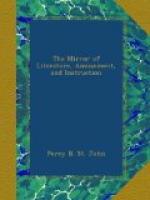The night passed not over the heads of the good folks of Lanport, without numberless recriminations on the stupidity which had been displayed in not arresting the stranger before it was too late; and the ferment was not lessened on the arrival of another copy of the —— Journal, which contained a paragraph headed with the glittering words, “ONE THOUSAND POUNDS REWARD.”
VYVYAN.
* * * * *
Spirit of Discovery.
* * * * *
THE ISLAND OF ROTUMA.[10]
“A new Cythera emerges from the bosom of the enchanted wave. An amphitheatre of verdure rises to our view; tufted groves mingle their foliage with the brilliant enamel of meadows; an eternal spring, combining with an eternal autumn, displays the opening blossoms along with the ripened fruit.”—Maltebrun.
[Illustration: The Island of Rotuma.]
This is one of the beautiful islands of Polynesia, in the South Pacific Ocean. It was discovered in the year 1791, and has been since occasionally visited by English and American whalers, and a few other ships, for the purpose of procuring water and a supply of vegetable productions, with which it abounds. It is situated in latitude 12 deg. 30’ south, and longitude 177 deg. east, and is distant about 260 miles from the nearest island of the Fidji group. It is of a moderate height, densely wooded, and abounding in cocoa-nut trees, and is about from thirty to thirty-five miles in circumference. Its general appearance is beautifully picturesque, verdant hills gradually rising from the sandy beach, giving it a highly fertile appearance. It is surrounded by extensive reefs, on which at low water the natives may be seen busily engaged in procuring shell and other fish, which are abundantly produced on them, and constitute one of their articles of daily food. At night, they fish by torch-light, lighting fires on the beach, by which the fish are attracted to the reefs. The torches are formed of the dried spathe or fronds of the cocoa-nut tree, and enable them to see the fish, which they take with hand-nets. It is by these lights that the fish are attracted, but not so in the opinion of the natives, who say, “they come to the reef at night to eat, then sleep, and leave again in the morning.”
[Mr. George Bennett, in his account of his recent visit, says:—]




